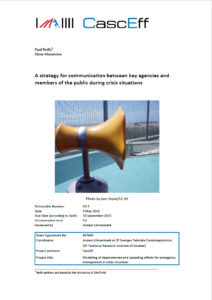The CascEff report on Glossary and Definitions has been published. 

 The report “A strategy for communication between key agencies and members of the public during crisis situations” has been updated (D3.3)
The report “A strategy for communication between key agencies and members of the public during crisis situations” has been updated (D3.3)
The objective of Task 2.5 is to investigate how computer modelling can be used as input to an Incident Evolution Tool (IET). In some situations the cascading effects depend on the physics and to fully understand the effect of incident management, also physical processes need to be modelled. Therefore, this task aims at modelling the necessary processes in order to support the simulated exercises in WP5 based on the physical effects identified in Task 2.3.
In total three scenarios are simulated within Task 2.5, two scenarios involved fire (Mont Blanc tunnel and wildland fire cases) and one scenario involved pollutant dispersion near a populated area. A detailed description of the numerical set-up used to model the scenarios is given and the results from the numerical simulations of the different test cases considered are analyzed. Based on the simulation results, valuable conclusions are drawn for each test case with regards to the viability of the use of numerical modelling as input for the IET to be developed within the project and for the simulated exercises to be performed within WP5.
Purpose – The scope of Task 1.4, as described in the Dow, is ‘the identification of basic and representative originators leading to scenarios with cascading effects’.
Design/Methodology/approach – This initial objective was extended to a more comprehensive methodological report on all aspects related to the elaboration of the scenarios for the purpose of testing the IET. In doing so, more efficiency and a more coherent methodological approach on linked aspects was aimed at:
As much information as possible from previous CascEff Deliverables and ongoing Tasks was used as the basis for the selection of scenario’s (scenario definition), the methodological steps to define evaluation criteria for testing and as input for multiple timeline development. The CascEff input is completed for the guidelines on elaboration of scenarios and a test script with relevant information from literature and national practices.
Three case studies were explored in order to develop a communication strategy that could be employed by key agencies in conjunction with members of the public during incidents that had the potential to generate cascading effects:
1) The floods in South-West England (December 2013 – February 2014);
2) The thunderstorm that hit the Pukkelpop music festival in Belgium (18 August 2011); and
3) The rioting in the town of Haren, in the Netherlands (21 September 2012), after thousands of young people gathered for a local girl’s birthday party advertised as ‘Project X Haren’.
The strategy was based on information gathered through a review of the literature on the role of the media in emergency management, an exploration of the communication strategies deployed by key agencies in each of these case studies, and the key findings from a critical thematic analysis of 41 semi-structured interviews conducted with key stakeholders between December 2014 and May 2015.
The CascEff project aims to improve the emergency response in incidents that involve cascading effects, i.e. where system dependencies lead to impacts propagating from one system to other systems. An important basis for this improvement is knowledge about the nature, processes and patterns of cascading effects. One way to gain such knowledge is to study past events.
The CascEff project started on April 1, 2014 and runs for 36 months. The project concerns modelling of dependencies and cascading effects for emergency management in crisis situations. The project aims to significantly improve the ability of Incident Commanders to manage complex incidents by improving our understanding of initiators, dependencies and key decision points through the use of the proposed Incident Evolution Tool.
The CascEff-project aims to improve the emergency response in incidents that involve cascading effects, i.e. where system dependencies lead to impacts propagating from one system to other systems. An important basis for this is knowledge about the nature, processes and patterns of cascading effects.